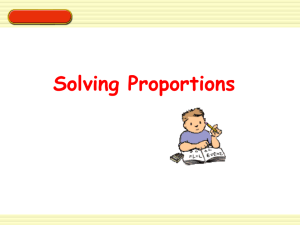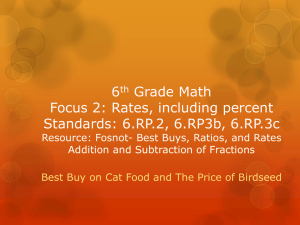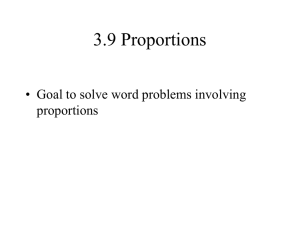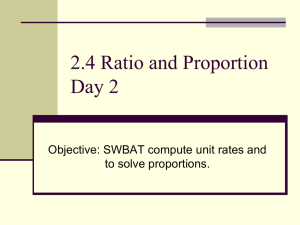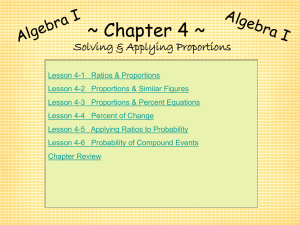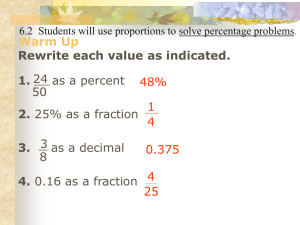ppt
advertisement
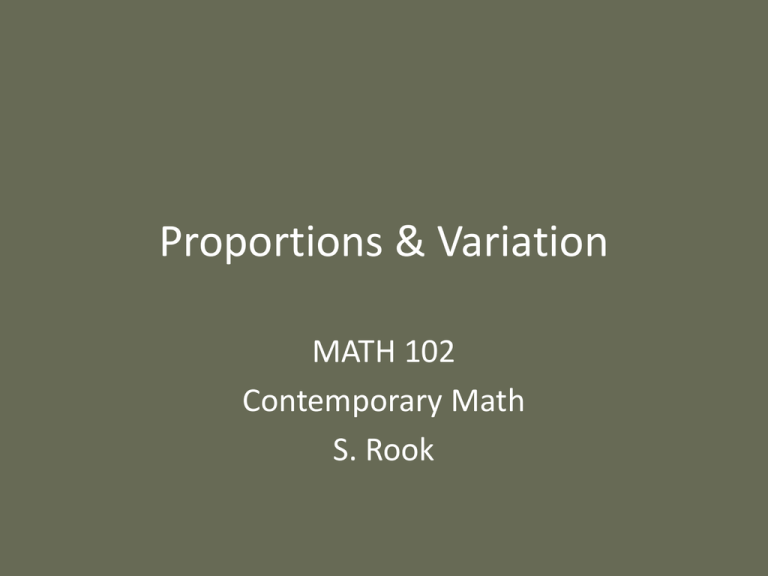
Proportions & Variation MATH 102 Contemporary Math S. Rook Overview • Section 7.5 in the textbook: – Ratios & proportions – Direct & inverse variation Ratios & Proportions Ratios & Proportions • Ratio – a quotient of two quantities e.g. 1/5 or x/(x – 1) – An expression • Proportion – a mathematical equation of two equal ratios Ex: 2/3 = 6/9 or x/(x – 1) = 7/8 – Only one fraction on each side of the = • We cross-multiply to solve a proportion e.g. x/4 = 1/2 4 Proportions (Example) Ex 1: Solve: a) b) x 3 12 2 30 27 40 x Using Proportions to Solve Word Problems • Key is to extract information from the word problem to set up proportions • Proportions compare two units – e.g. cups of sugar to batches, number of cards to people, etc • Align the units – e.g. Put cups of sugar is in the numerator and batches in the denominator for both sides of the proportion – DO NOT mix up the units on each side 6 Proportions & Word Problems (Example) Ex 2: The dosage of a particular drug is proportional to the patient’s body weight. If the dosage for a 150-pound woman is 6 milligrams, what would the dosage be for her daughter who weighs 65 pounds? Proportions & Word Problems (Example) Ex 3: If 36 cookies require 1.5 cups of sugar, how many cookies can be made with 4 cups of sugar? Direct & Inverse Variation Variation in General • Given two quantities that are related, variation refers to how either increasing or decreasing the first quantity affects the second quantity • Because the two quantities are related, they differ by only a constant value – This constant is called the constant of proportionality and is often denoted by k • We can model variation by equations 10 Direct Variation • Direct variation: situations that can be modeled with the formula y = kx where x and y represent the two quantities k is the constant of proportionality • The following statements are all equivalent and indicative of direct variation (also in the book): y varies directly as x y is directly proportional to x y = kx for some nonzero constant k 11 Inverse Variation • Inverse variation: situations that can be modeled with the formula y = k⁄x where x and y represent the two quantities k is the constant of proportionality • The following statements are all equivalent and indicative of inverse variation (also in the book): y varies inversely as x y is inversely proportional to x y = k⁄x for some nonzero constant k 12 Direct & Inverse Variation (Example) Ex 4: Solve: a) Assume that y varies directly as x. If y = 37.5 when x = 7.5, what is the value for y when x = 13? b) Assume that r varies inversely as s. If r = 12 when s = 2⁄3, what is the value for r when s = 8? Direct & Inverse Variation (Example) Ex 5: The volume of a cylinder varies directly with the square of its radius AND its height. If the volume of a cylinder with a radius of 5 cm and height of 2 cm is 157.08 cm2, find the volume of a cylinder with a radius of 7 cm and a height of 10 cm. Summary • After studying these slides, you should know how to do the following: – Solve proportions and word problems containing proportions – Solve problems involving direct and inverse variation • Additional Practice: – See problems in Section 7.5 • Next Lesson: – Percent Change & Taxes (Section 9.1)


